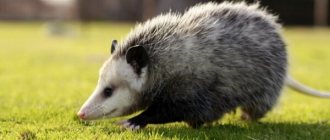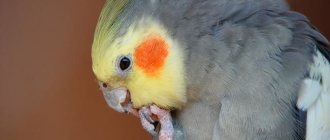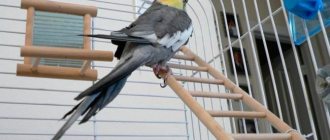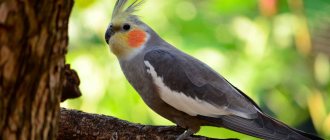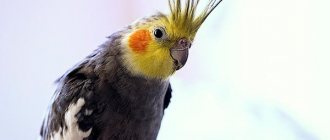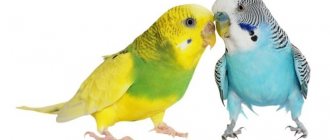The Corella parrot breeds easily in captivity, and this suits breeders. Professional breeders, through many years of selection, have managed to breed many subspecies of these beautiful birds. Artificial breeding has so affected the color of the plumage that all sexual characteristics are mixed up. Now it can be difficult to recognize whether the cockatiel is a boy or a girl.
Methods for determining the sex of a cockatiel
Corellas do not have clearly defined sexual characteristics, so even an experienced breeder does not always understand who is in front of him: a female or a male. In most cases, people buy birds in pet stores and markets, where sellers are interested in a quick sale. They don't need to understand the sexual dimorphism of parrots. In order to sell live goods from your hands, they will confirm to you what you want to hear.
Let's say you take home a bird for the first time. It’s okay if the purchased chick turns out to be the wrong sex: starting to get acquainted with parrots is interesting in any case. But when you purposefully follow a boy or girl, theoretical knowledge will not hurt. At an early age, you can determine the sex of a cockatiel based on three methods:
- Appearance and behavior. The characteristic features of males and females appear only after the first moult; before that, they are colored the same, and their habits are almost the same. Of course, no one forbids making assumptions, but obvious differences will arise once the parrot reaches puberty.
- Laboratory DNA analysis. Gives a high probability of determining gender.
- Genetics. The accuracy of the method is from 50 to 100%. The difficulty is that to find out the sex of the chick you need to see its parents. When purchasing from a store rather than from a breeder, there is no guarantee of the right choice. There is no need to go into detail about the structure of chromosomes; you can simply compare the parrot with mom and dad.
If you are breeding cockatiels, take a closer look at the growing chicks, note the signs inherent in one or the other sex. Boys begin to sing at about three months, so it doesn’t hurt to mark the paw of the supposed male with a ring. This will help guide you in the future when selling birds, because during molting all differences between male and female birds disappear.
When is the easiest time to find out the sex of a cockatiel (nymph)
Until 10–12 months of age, nymphs are colored the same - a basic gray color and brown spots on the cheeks. And only after reaching this age the color of the males changes, after which it is possible to determine the sex of the bird with great accuracy.
Before this period, whether you are a girl or a boy can only be determined using other methods, for example, by behavior or a DNA test.
Did you know? The cockatiel can express its emotions through sign language. So, she expresses interest by tilting her head, raising her crest and squinting her eyes, fear - by pressing her head into her shoulders and pressing her crest, surprise - by raising and spreading her crest, wide-open eyes, rage - by spreading her crest, holding her head high and twitching.
Appearance
It is a little easier to determine the sex of a cockatiel that is more than a year old, because by this time the bird has acquired new feathers and matured physically. In the appearance of an adult parrot, features appear that indicate belonging to a specific gender:
- in the male the tail is wedge-shaped, pointed, in the female it is in the form of a blade;
- the structure of the female’s pelvic bones does not allow her to place her paws close, she sits low and walks like a duck;
- The boy has a curved narrow crest, wide at the base, the girl has a more magnificent and straight crest;
- the female is large and heavy, the body shape is round;
- Regardless of the subspecies, the male is brighter and more attractive than the female.
This method of sex recognition can be called relatively truthful, since two birds of different sexes are compared to identify gender differences. If you have one parrot, you can only judge its gender based on its appearance only conditionally.
There is no point in asking experts on forums or sending photos of cockatiels to breeders. A frozen image of a bird will not tell you anything; it is impossible to determine the gender with its help.
How to distinguish a female from a male by appearance?
Once the bird has reached one year of age, you can try to determine its sex by color. The color variety of cockatiels is quite extensive, but in nature, pale grayish individuals are mainly found. Males with this plumage can be identified by their yellow head and crest; females are distinguished by their leaden tint and the presence of pale speckles on their cheeks. The tail of an adult male darkens to black, and the painting on the inside of the wings is lost. In females, the decorations are preserved and look like narrow horizontal stripes of bright color and inclusions.
In nature, determining the sex of a cockatiel is not so difficult, which cannot be said about poultry. Thus, the lutino color, characterized by white color, does not allow determining the sex of the bird until it is one year old. In older individuals, you can take a closer look at the tail plumage.
The pearl color is popular among breeders. Such birds have a pearly gray color. In males, the plumage gradually becomes monochromatic, and the tail acquires a black tint, as in nature. In girls after the age of one and a half years, the plumage turns yellowish. The mother-of-pearl ornament in females remains until the end of life.
White-faced cockatiels have a white coloration without pronounced spots on the cheekbones and with a complete absence of a yellowish tint. Boys have a completely snow-white color, and females are distinguished by a gray or brown crest. Albino cockatiels also have a similar color. In this case, females are distinguished by a slight yellowish tint and amber specks on the wings, while males have snow-white plumage. Albino cubs are born with red eyes, which gradually acquire a juicy cherry hue.
These are blackwing, shecky, black, pied or harlequin. Females of the Corella breed are usually larger than males, both in appearance and in weight, but the forehead of boys appears wider due to a more voluminous crest at the very base.
Read with this
- Login to the site
- All about diseases of Corella parrots (nymph)
- Everything you need to know about caring for budgies at home
- How to toilet train a dog using a diaper
- How to care for budgies at home?
- Reinforcement learning in machine learning
- Wintering (sedentary) and nomadic birds: list of species, names, photos and characteristics
- Selecting a cage for a cockatiel: dimensions and design
- How to care for a ferret at home
- Making a parrot cage with your own hands
Characteristic behavior
Breeders note that adult males and females are strikingly different from each other in habits. This is what boys do:
- they sing loudly, especially when the reproductive instinct awakens;
- tap dance with their beaks on ringing surfaces;
- protrude the wings and fold them in the shape of a heart;
- walk freely towards a person, are not afraid of hands;
- they put their paw on their cage neighbor, showing the character of a conqueror.
Corella girls do not strive to amaze others with their talents. They are phlegmatic, modest, quiet. They don't sing, they coo. They don’t allow you to pull yourself together, they swear and bite. They are constantly busy organizing their home. During mating games, the female accepts courtship, and the male displays himself and shows himself in all his glory.
A bird living alone suddenly laid an egg - this is a female, now there can be no mistake. This is one of two cases when you can find out the sex of a cockatiel with 100% accuracy.
DNA analysis
The second case that gives confidence that a bird belongs to one sex or another is DNA analysis. The effectiveness of using this method has long been proven, but its cost is too high. In addition, laboratories engaged in such analyzes are located only in large cities. You need to have a good reason to try to determine the sex of a cockatiel using DNA.
The laboratory takes feathers, blood or sewage from the cloaca for analysis. Identification of newborn chicks is possible by the shell with membrane from which they hatched. If feathers are chosen as the object of study, they need to be specially plucked - those that fall out on their own are not suitable. The down under the wing is not informative; medium feathers with a white tip are taken. At the end of the work, the laboratory technician sends the result by email or notifies you by phone.
The selected material must be submitted for verification within two days.
Plumage color
As they grow older, all parrots go through a juvenile molt - a radical change in plumage. The inconspicuous baby fluff sheds, and is replaced by dense, richly colored feathers. In cockatiels, this occurs between 8 and 12 months. Usually, by the second year of life, a bird acquires the feather color that was genetically determined by its parents. It is much easier to distinguish a male from a female if they have a dominant gray color, but with some mutations this is almost impossible to do by appearance.
Natural gray
The natural cockatiel is called dimorphic, which means there is a clear difference between birds of opposite sexes. Natural coloring makes it easy to determine the sex of a cockatiel parrot. The boys' body is covered with gray feathers, on the head there is a yellow mask and a crest. Round orange spots “bloom” on the cheeks.
The girls are a little lighter, their feathers seem to be sprinkled with dust. The gray mask is slightly diluted with yellow, the crest is brown. The cheeks of a young female are light yellow, and with age they acquire a brick tint. The tail feathers are slightly yellowed along the edges and marked with horizontal black stripes along their entire length. Light spots are barely noticeable on the inside of the wings.
White-faced cheekless
These birds have different colors, with the exception of lutino. They do not have yellow pigment. A clear peculiar feature is the absence of orange circles on the cheeks. The mask on the head of the male is pure white; in females there is an admixture of gray or cinnamon shades.
Lyutino
Bright color, artificially bred. The mutation gene suppresses natural coloring, resulting in yellow parrots mixed with white. Red-eyed males are identical in appearance to females, making it extremely difficult to determine their gender. If you're lucky, you'll find dark streaks on the bird's tail and dots on the wings, like natural cockatiels. This means that this is a female.
Pearl barley
Corellas, whose coloring is called “pearl,” look very impressive: their feathers have a special pearl-shaped pattern. The center of the feather is white or yellow, and the edges are darkened. The first molt deprives the male of all his beauty, or it happens after a while, but the female remains beautiful for her entire life.
Albino
Albino males and females are white, their mask and forelock are yellow. The cheek spots are the same, the eyes are red. A minor difference with the female is that her wings and tail appear to have been sprayed with pale yellow paint.
White
A very expressive mutation, it appears from crossing gray males with albino females. The result of selection is white cockatiels with a sunny yellow tint of feathers. The eyes of such majestic individuals are usually black. How to recognize a white male? The tail feathers on his tail are white, without any impurities.
The second sign is the color of the plumage
This sign applies only to adult birds. With chicks everything is much more complicated. Experienced breeders try to predict gender based on genetic predisposition when they know everything about the babies’ parents. And the color of the plumage will help you find out the sex of an adult bird that has undergone its first molt. The naturally gray male cockatiel has more yellow on his head and his orange cheeks are clearly outlined.
Girls have more gray on their heads, and their cheeks are paler and blurred. It is more difficult with cockatiels of other colors. Lutino females are thought to have dark stripes on their lower tail feathers. In principle, females of all colors should have light spots on their wing feathers and dark stripes on their tails.
For white cockatiels, the principle of sex determination is as follows: males have whiter plumage, while females may have a yellowish tint. Of course, all the colors of the parrot that are different from the natural ones, obtained as a result of many crossings, make it extremely difficult to determine the sex of birds.
